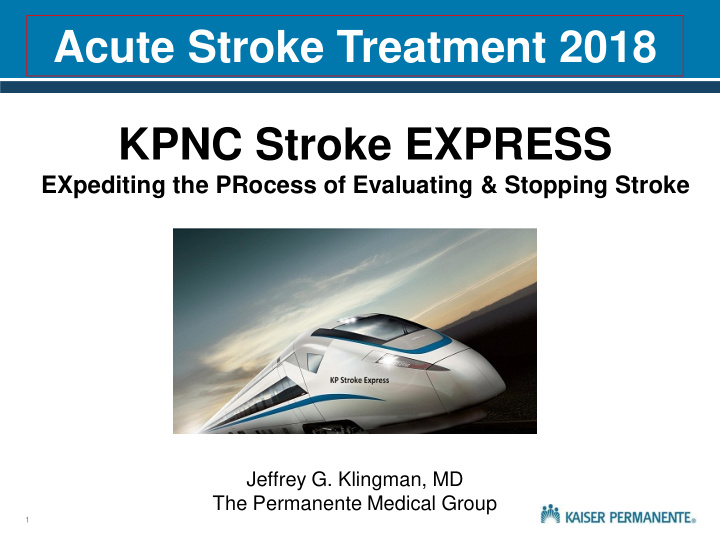



Acute Stroke Treatment 2018 KPNC Stroke EXPRESS EXpediting the PRocess of Evaluating & Stopping Stroke Jeffrey G. Klingman, MD The Permanente Medical Group 1
Stroke Treatment in “the old days” Prior to 1996: back corner of Emergency Department
1996: Revolution in Stroke Treatment : IV t-PA 1996-2011; IV alteplase (t-PA) < 3 hours Number Needed to Treat (NNT) = 4 to prevent major disability Faster is better
2011: IV Alteplase to 4.5 hours 2011 IV Alteplase window expands to 4.5 hours No benefit beyond 4.5 hours
2013: Endovascular Stroke Treatment (EST) does NOT work 2013: 3 studies - no benefit to endovascular treatment vs IV alteplase N Engl J Med 2013 MR RESCUE IMS III SYNTHESIS Embolectomy was not Randomly assigned eligible patients Endovascular therapy is not superior to superior to standard who had received intravenous t-PA medical care in patients within 3 hours after symptom onset standard treatment with with either a favorable to receive additional endovascular intravenous t-PA. penumbral pattern or a therapy or ntravenous t-PA alone. nonpenumbral pattern The study was stopped early because of futility
2016: EST does work (in selected patients) 2016: 4 studies show benefit of endovascular treatment in some stroke patients up to 6 hours Still time sensitive Many fewer patients qualify Difference from 2013 was patient selection and devices
2018: The Window Extends : 6 to 24 hours 2018: DAWN and DEFUSE - 3: benefit to 6 -24 and 6- 16 hours in highly selected Large Vessel Occlusion (LVO) patents NNT 2-3 DAWN DEFUSE 3 Hours 6-24 6-16 Rankin < 2 < 3 NIHSS > 9 > 5 CTA LVO in M1 or ACA LVO in M1 or ACA Core < 70ml on advanced <70ml AND mismatch imaging ratio of >1.8 AND penumbra of >15ml on advanced imaging
What would it take to… Achieve “world class” (15 - 20 minutes) door to needle (DTN) times? Obtain very rapid CT angiogram (CTA) performance and interpretation? Treat, evaluate, and transfer for endovascular therapy very quickly 8
Stroke EXPRESS: Key Components Direct to CT and Rapid Transfer for Early Stroke Neurologist Video Engagement EST CTA Rapid assessment If potential candidate Alteplase Early alteplase for EST, ambulance administered in CT ordering pre-ordered before suite Processes Nearly all patients CT/CTA completed redesigned for receive a CTA maximal efficiency Stroke . 2018;49:133-139
Population evaluation by teleneurologist Every patient is seen and evaluated on arrival by teleneurologist Standardized searchable notes including Stroke alerts cancelled on arrival and why Strokes treated and outcomes including NIHSS exam Presence and location of LVO Transfers for EST Early Stroke Neurologist Video Engagement
Results
Results
True or False? More patients are eligible for treatment with IV alteplase than are treated with endovascular therapy. A. True B. False Endovascular Therapy IV alteplase 0% 0% False True Response 20 Counter
Endovascular therapy is rare 18 acute strokes were evaluated to find 1 patient eligible for EST 2546 patients eligible for acute stroke treatment were identified and brought to us by paramedics. Of these patients, 1241 (48.7%) had acute strokes. 600 Treated with IV Alteplase (4X as many as EST) Of the acute strokes, 638 (25%) were potential candidates for endovascular treatment (NIHSS >7) Of these, 141 patients (5.5% of total / 22% of high score) ended up actually having large vessel occlusion and received endovascular therapy.
What about the extended window patients? • Unknown number of patients will qualify for treatment • Nobody has reported number screened for DAWN or DEFUSE 3 • EXTEND – IA found 70 candidates for treatment out of 549 patients with LVO (13%) • 1.7% of all stroke patients (45/2667) qualified for DAWN criteria in one recent study • Systems of care need to be prepared to screen potential late window patients • Last known well • Baseline Rankin • NIHSS > 5 (or >9) • CT shows no bleed • CTA shows occlusion • CTP (or MRI) shows small core / perfusion mismatch
Endovascular Stroke Treatment Time is brain / faster is better EST is an infrequent, highly specialized treatment Many more patients need IV alteplase than EST (80%) Not all centers should do EST Like may procedural specialties experience and volume matters Minimum 30 treatments per centers per year and 12 per doc per site Rapid identification of EST, patient selection, and transfer is the key
Conclusions Acute stroke is a treatable condition Time is critical High functioning primary stroke centers are the key to successful treatment Rapid clinical evaluation Rapid IV alteplase Rapid CTA (Rapid CTP / MRI for late presenting patients) Rapid transfer of selected patients to endovascular treatment centers High functioning Endovascular Stroke Treatment Centers Expedited patient acceptance Adequate volume Excellent treatment times and results
Recommend
More recommend